14.2 Seedless Plants
Learning Objectives
By the end of this section, you will be able to:
- Describe the distinguishing traits of the three types of bryophytes
- Identify the new traits that first appear in seedless vascular plants
- Describe the major classes of seedless vascular plants
An incredible variety of seedless plants populates the terrestrial landscape. Mosses grow on tree trunks, and horsetails (Figure 14.9) display their jointed stems and spindly leaves on the forest floor. Yet, seedless plants represent only a small fraction of the plants in our environment. Three hundred million years ago, seedless plants dominated the landscape and grew in the enormous swampy forests of the Carboniferous period. Their decomposing bodies created large deposits of coal that we mine today.
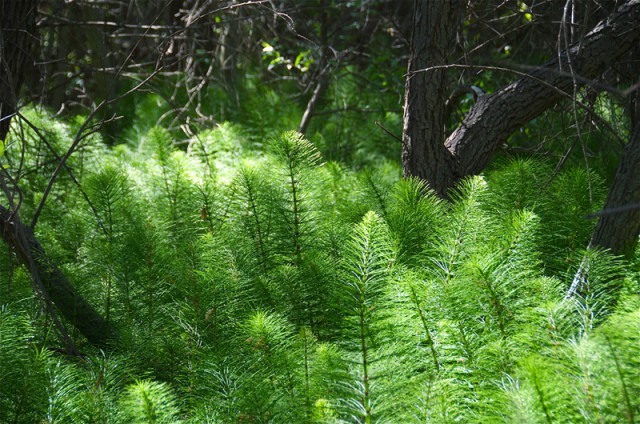
Bryophytes
Bryophytes, an informal grouping of the nonvascular plants, are the closest extant relative of early terrestrial plants. The first bryophytes most probably appeared in the Ordovician period, about 490 million years ago. Because of the lack of lignin—the tough polymer in cell walls in the stems of vascular plants—and other resistant structures, the likelihood of bryophytes forming fossils is rather small, though some spores made up of sporopollenin have been discovered that have been attributed to early bryophytes. By the Silurian period (440 million years ago), however, vascular plants had spread throughout the continents. This fact is used as evidence that nonvascular plants must have preceded the Silurian period.
There are about 18,000 species of bryophytes, which thrive mostly in damp habitats, although some grow in deserts. They constitute the major flora of inhospitable environments like the tundra, where their small size and tolerance to desiccation offer distinct advantages. They do not have the specialized cells that conduct fluids found in the vascular plants, and generally lack lignin. In bryophytes, water and nutrients circulate inside specialized conducting cells. Although the name nontracheophyte is more accurate, bryophytes are commonly referred to as nonvascular plants.
In a bryophyte, all the conspicuous vegetative organs belong to the haploid organism, or gametophyte. The diploid sporophyte is barely noticeable. The gametes formed by bryophytes swim using flagella. The sporangium, the multicellular sexual reproductive structure, is present in bryophytes. The embryo also remains attached to the parent plant, which nourishes it. This is a characteristic of land plants.
The bryophytes are divided into three divisions (in plants, the taxonomic level “division” is used instead of phylum): the liverworts, or Marchantiophyta; the hornworts, or Anthocerotophyta; and the mosses, or true Bryophyta.
Liverworts
Liverworts (Marchantiophyta) may be viewed as the plants most closely related to the ancestor that moved to land. Liverworts have colonized many habitats on Earth and diversified to more than 6,000 existing species (Figure 14.10a). Some gametophytes form lobate green structures, as seen in Figure 14.10b. The shape is similar to the lobes of the liver and, hence, provides the origin of the common name given to the division.
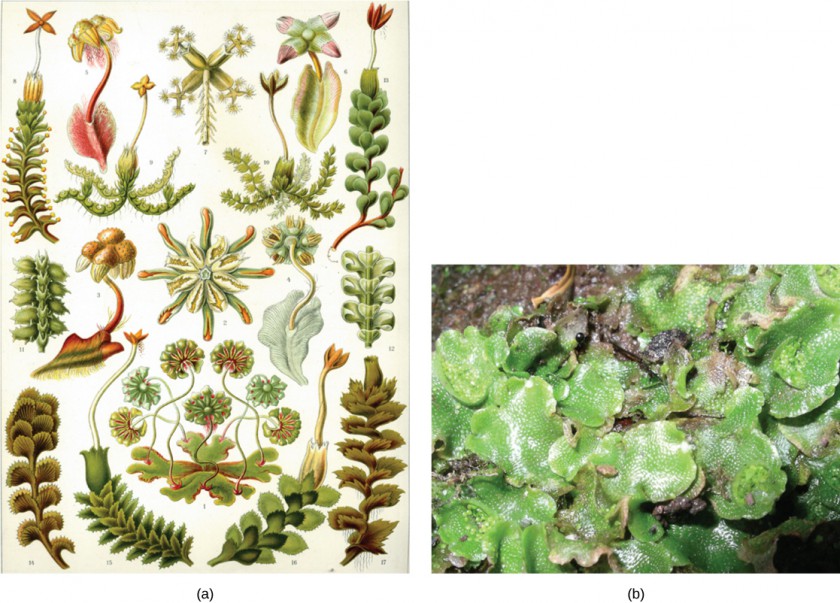
Hornworts
The hornworts (Anthocerotophyta) have colonized a variety of habitats on land, although they are never far from a source of moisture. There are about 100 described species of hornworts. The dominant phase of the life cycle of hornworts is the short, blue-green gametophyte. The sporophyte is the defining characteristic of the group. It is a long and narrow pipe-like structure that emerges from the parent gametophyte and maintains growth throughout the life of the plant (Figure 14.11).
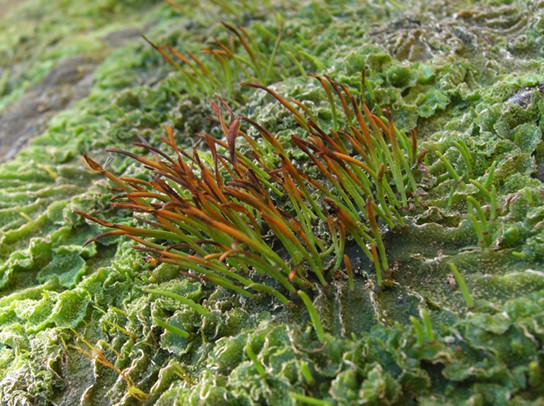
Mosses
More than 12,000 species of mosses have been catalogued. Their habitats vary from the tundra, where they are the main vegetation, to the understory of tropical forests. In the tundra, their shallow rhizoids allow them to fasten to a substrate without digging into the frozen soil. They slow down erosion, store moisture and soil nutrients, and provide shelter for small animals and food for larger herbivores, such as the musk ox. Mosses are very sensitive to air pollution and are used to monitor the quality of air. The sensitivity of mosses to copper salts makes these salts a common ingredient of compounds marketed to eliminate mosses in lawns (Figure 14.12).
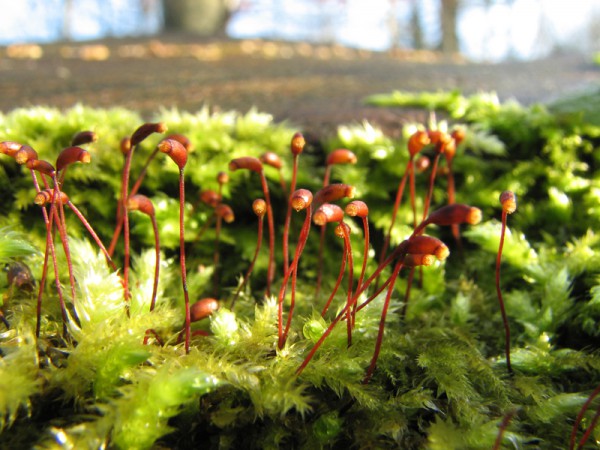
Vascular Plants
The vascular plants are the dominant and most conspicuous group of land plants. There are about 275,000 species of vascular plants, which represent more than 90 percent of Earth’s vegetation. Several evolutionary innovations explain their success and their spread to so many habitats.
Vascular Tissue: Xylem and Phloem
The first fossils that show the presence of vascular tissue are dated to the Silurian period, about 430 million years ago. The simplest arrangement of conductive cells shows a pattern of xylem at the center surrounded by phloem. Xylem is the tissue responsible for long-distance transport of water and minerals, the transfer of water-soluble growth factors from the organs of synthesis to the target organs, and storage of water and nutrients.
A second type of vascular tissue is phloem, which transports sugars, proteins, and other solutes through the plant. Phloem cells are divided into sieve elements, or conducting cells, and supportive tissue. Together, xylem and phloem tissues form the vascular system of plants.
Roots: Support for the Plant
Roots are not well preserved in the fossil record; nevertheless, it seems that they did appear later in evolution than vascular tissue. The development of an extensive network of roots represented a significant new feature of vascular plants. Thin rhizoids attached the bryophytes to the substrate. Their rather flimsy filaments did not provide a strong anchor for the plant; neither did they absorb water and nutrients. In contrast, roots, with their prominent vascular tissue system, transfer water and minerals from the soil to the rest of the plant. The extensive network of roots that penetrates deep in the ground to reach sources of water also stabilizes trees by acting as ballast and an anchor. The majority of roots establish a symbiotic relationship with fungi, forming mycorrhizae. In the mycorrhizae, fungal hyphae grow around the root and within the root around the cells, and in some instances within the cells. This benefits the plant by greatly increasing the surface area for absorption.
Leaves, Sporophylls, and Strobili
A third adaptation marks seedless vascular plants. Accompanying the prominence of the sporophyte and the development of vascular tissue, the appearance of true leaves improved photosynthetic efficiency. Leaves capture more sunlight with their increased surface area.
In addition to photosynthesis, leaves play another role in the life of the plants. Pinecones, mature fronds of ferns, and flowers are all sporophylls—leaves that were modified structurally to bear sporangia. Strobili are structures that contain the sporangia. They are prominent in conifers and are known commonly as cones: for example, the pine cones of pine trees.
Seedless Vascular Plants
By the Late Devonian period (385 million years ago), plants had evolved vascular tissue, well-defined leaves, and root systems. With these advantages, plants increased in height and size. During the Carboniferous period (359–299 million years ago), swamp forests of club mosses and horsetails, with some specimens reaching more than 30 meters tall, covered most of the land. These forests gave rise to the extensive coal deposits that gave the Carboniferous its name. In seedless vascular plants, the sporophyte became the dominant phase of the lifecycle.
Water is still required for fertilization of seedless vascular plants, and most favor a moist environment. Modern-day seedless vascular plants include club mosses, horsetails, ferns, and whisk ferns.
Club Mosses
The club mosses, or Lycophyta, are the earliest group of seedless vascular plants. They dominated the landscape of the Carboniferous period, growing into tall trees and forming large swamp forests. Today’s club mosses are diminutive, evergreen plants consisting of a stem (which may be branched) and small leaves called microphylls (Figure 14.13). The division Lycophyta consists of close to 1,000 species, including quillworts (Isoetales), club mosses (Lycopodiales), and spike mosses (Selaginellales): none of which is a true moss.
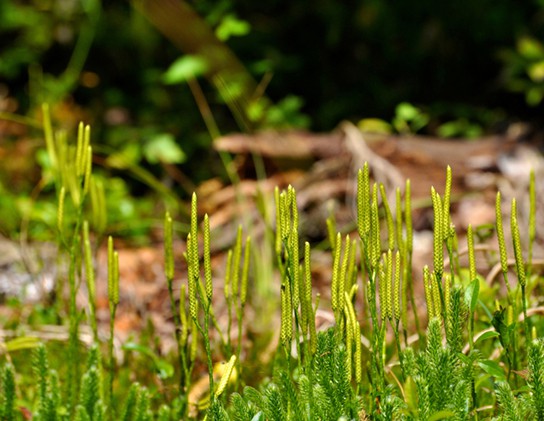
Horsetails
Ferns and whisk ferns belong to the division Pterophyta. A third group of plants in the Pterophyta, the horsetails, is sometimes classified separately from ferns. Horsetails have a single genus, Equisetum. They are the survivors of a large group of plants, known as Arthrophyta, which produced large trees and entire swamp forests in the Carboniferous. The plants are usually found in damp environments and marshes (Figure 14.14).
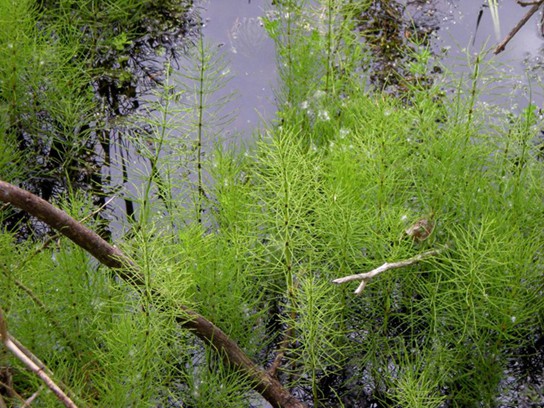
The stem of a horsetail is characterized by the presence of joints, or nodes: hence the name Arthrophyta, which means “jointed plant”. Leaves and branches come out as whorls from the evenly spaced rings. The needle-shaped leaves do not contribute greatly to photosynthesis, the majority of which takes place in the green stem (14.15Figure 7).
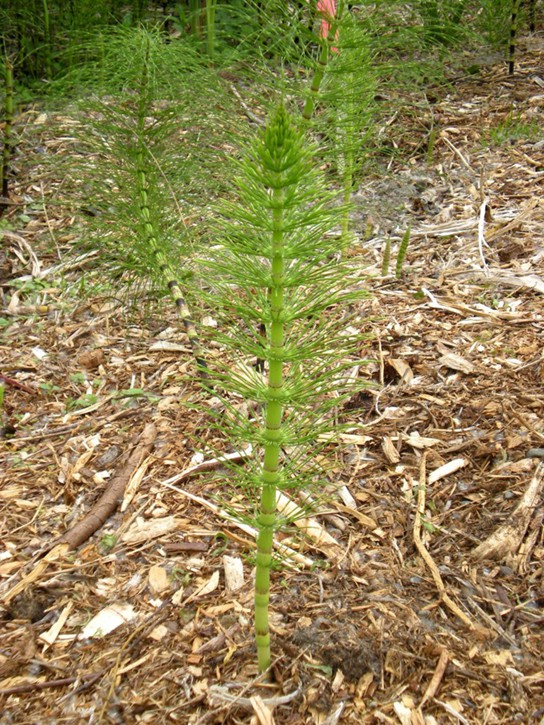
Ferns and Whisk Ferns
Ferns are considered the most advanced seedless vascular plants and display characteristics commonly observed in seed plants. Ferns form large leaves and branching roots. In contrast, whisk ferns, the psilophytes, lack both roots and leaves, which were probably lost by evolutionary reduction. Evolutionary reduction is a process by which natural selection reduces the size of a structure that is no longer favorable in a particular environment. Photosynthesis takes place in the green stem of a whisk fern. Small yellow knobs form at the tip of the branch stem and contain the sporangia. Whisk ferns have been classified outside the true ferns; however, recent comparative analysis of DNA suggests that this group may have lost both vascular tissue and roots through evolution, and is actually closely related to ferns.
With their large fronds, ferns are the most readily recognizable seedless vascular plants (Figure 14.16). About 12,000 species of ferns live in environments ranging from tropics to temperate forests. Although some species survive in dry environments, most ferns are restricted to moist and shaded places. They made their appearance in the fossil record during the Devonian period (416–359 million years ago) and expanded during the Carboniferous period, 359–299 million years ago (Figure 14.16).
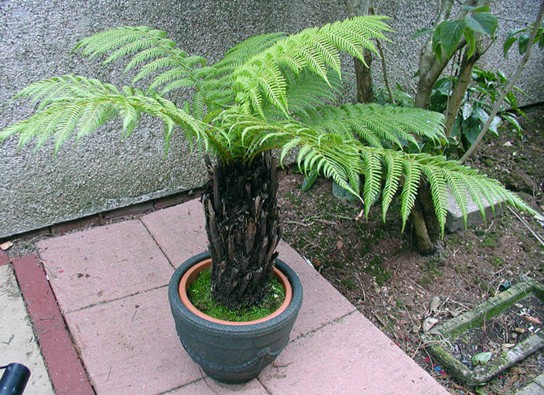
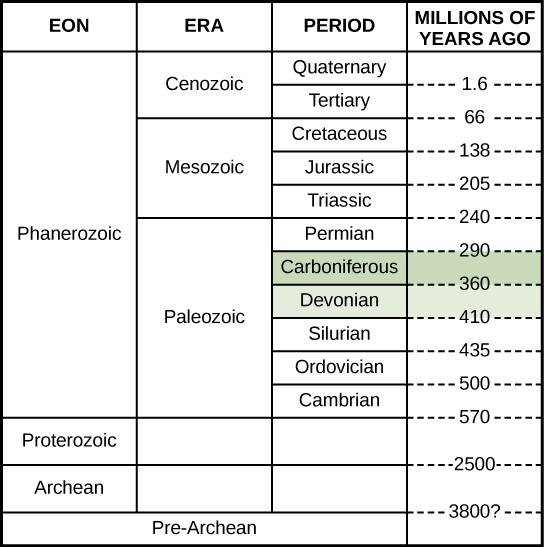
Concept in Action

Watch this video to see an animation of the lifecycle of a fern and to test your knowledge.
Career Connection
Landscape Designer
Looking at the well-laid gardens of flowers and fountains seen in royal castles and historic houses of Europe, it is clear that the creators of those gardens knew more than art and design. They were also familiar with the biology of the plants they chose. Landscape design also has strong roots in the United States’ tradition. A prime example of early American classical design is Monticello, Thomas Jefferson’s private estate; among his many other interests, Jefferson maintained a passion for botany. Landscape layout can encompass a small private space, like a backyard garden; public gathering places, like Central Park in New York City; or an entire city plan, like Pierre L’Enfant’s design for Washington, DC.
A landscape designer will plan traditional public spaces—such as botanical gardens, parks, college campuses, gardens, and larger developments—as well as natural areas and private gardens (Figure 14.18). The restoration of natural places encroached upon by human intervention, such as wetlands, also requires the expertise of a landscape designer.
With such an array of required skills, a landscape designer’s education includes a solid background in botany, soil science, plant pathology, entomology, and horticulture. Coursework in architecture and design software is also required for the completion of the degree. The successful design of a landscape rests on an extensive knowledge of plant growth requirements, such as light and shade, moisture levels, compatibility of different species, and susceptibility to pathogens and pests. For example, mosses and ferns will thrive in a shaded area where fountains provide moisture; cacti, on the other hand, would not fare well in that environment. The future growth of the individual plants must be taken into account to avoid crowding and competition for light and nutrients. The appearance of the space over time is also of concern. Shapes, colors, and biology must be balanced for a well-maintained and sustainable green space. Art, architecture, and biology blend in a beautifully designed and implemented landscape.
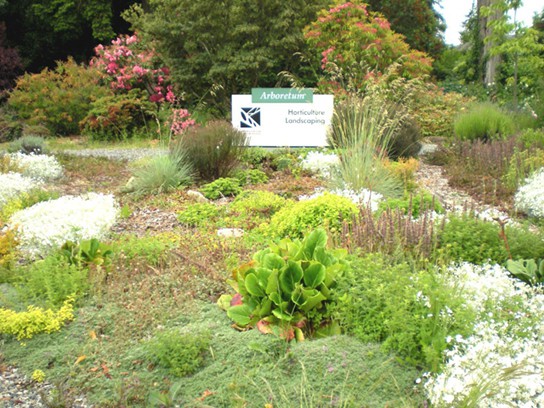
Section Summary
Seedless nonvascular plants are small. The dominant stage of the life cycle is the gametophyte. Without a vascular system and roots, they absorb water and nutrients through all of their exposed surfaces. There are three main groups: the liverworts, the hornworts, and the mosses. They are collectively known as bryophytes.
Vascular systems consist of xylem tissue, which transports water and minerals, and phloem tissue, which transports sugars and proteins. With the vascular system, there appeared leaves—large photosynthetic organs—and roots to absorb water from the ground. The seedless vascular plants include club mosses, which are the most primitive; whisk ferns, which lost leaves and roots by reductive evolution; horsetails, and ferns.
Glossary
- club moss: the earliest group of seedless vascular plants
- fern: a seedless vascular plant that produces large fronds; the most advanced group of seedless vascular plants
- hornwort: a group of non-vascular plants in which stomata appear
- horsetail: a seedless vascular plant characterized by a jointed stem
- liverwort: the most primitive group of non-vascular plants
- moss: a group of plants in which a primitive conductive system appears
- phloem: the vascular tissue responsible for transport of sugars, proteins, and other solutes
- sporophyll: a leaf modified structurally to bear sporangia
- strobili: cone-like structures that contain the sporangia
- whisk fern: a seedless vascular plant that lost roots and leaves by evolutionary reduction
- xylem: the vascular tissue responsible for long-distance transport of water and nutrients
Media Attributions
- Figure 14.9 © Jerry Kirkhart; OpenStax is licensed under a CC BY (Attribution) license
- Figure 14.10 © OpenStax is licensed under a CC BY (Attribution) license
- Figure 14.11 © Modification of work by Jason Hollinger; OpenStax is licensed under a CC BY (Attribution) license
- Figure 14.12 © "Lordgrunt"/Wikimedia Commons; OpenStax is licensed under a CC BY (Attribution) license
- Figure 14.13 © Cory Zanker; OpenStax is licensed under a CC BY (Attribution) license
- Figure 14.14 © Myriam Feldman; OpenStax is licensed under a CC BY (Attribution) license
- Figure 14.15 © Myriam Feldman; OpenStax is licensed under a CC BY (Attribution) license
- Figure 14.16 © Adrian Pingstone; OpenStax is licensed under a CC BY (Attribution) license
- Figure 14.17 © Modification of work by USGS; OpenStax is licensed under a CC BY (Attribution) license
- 14.2QR
- Figure 14.18 © Myriam Feldman; OpenStax is licensed under a CC BY (Attribution) license

